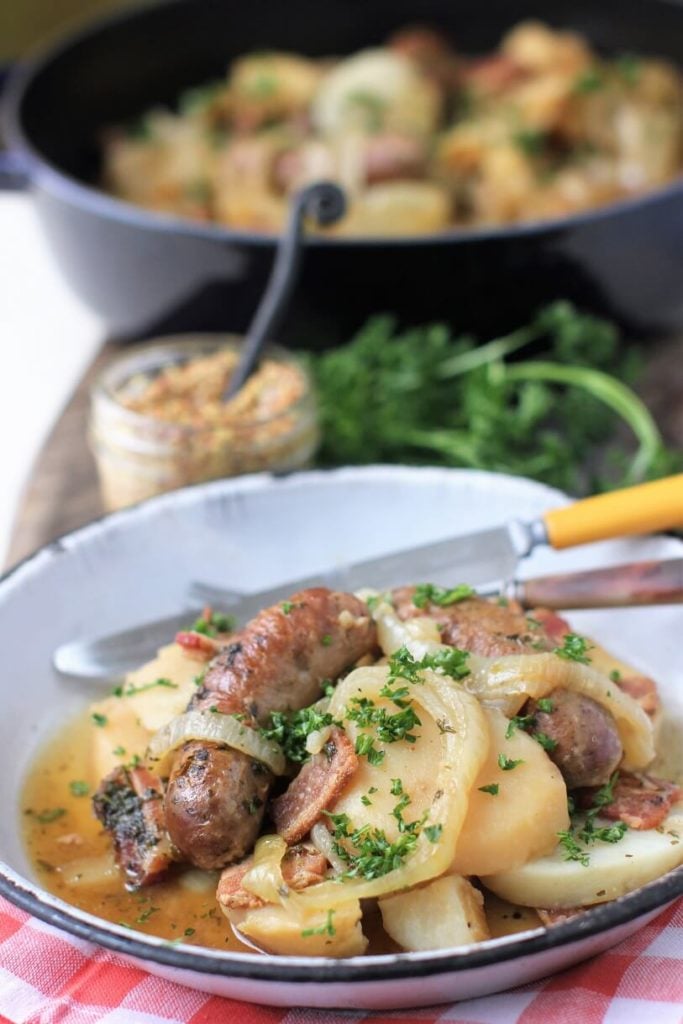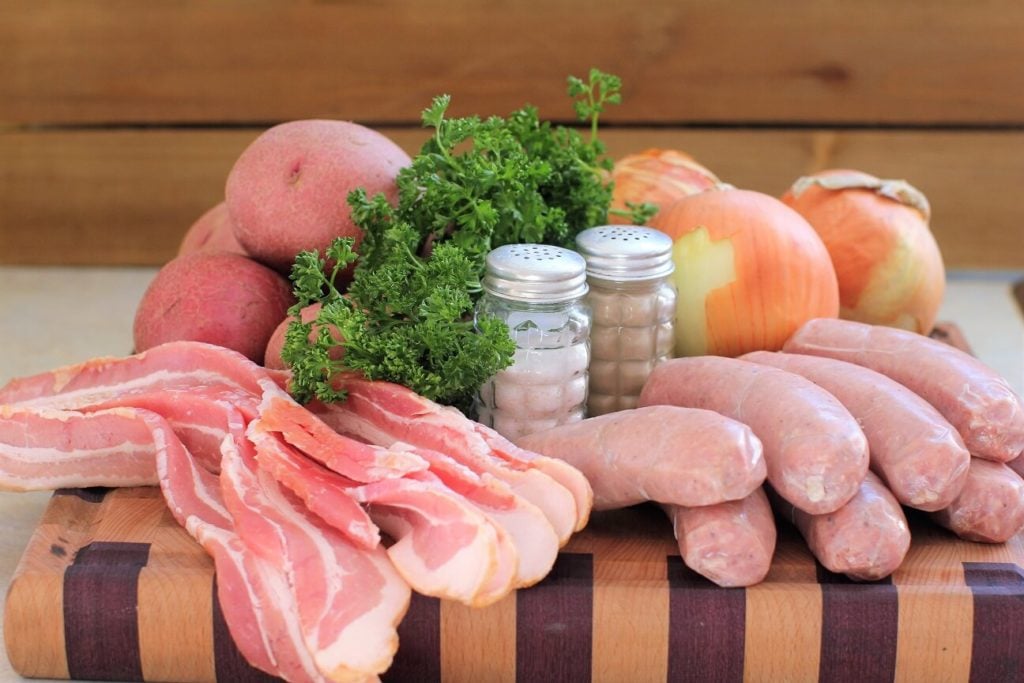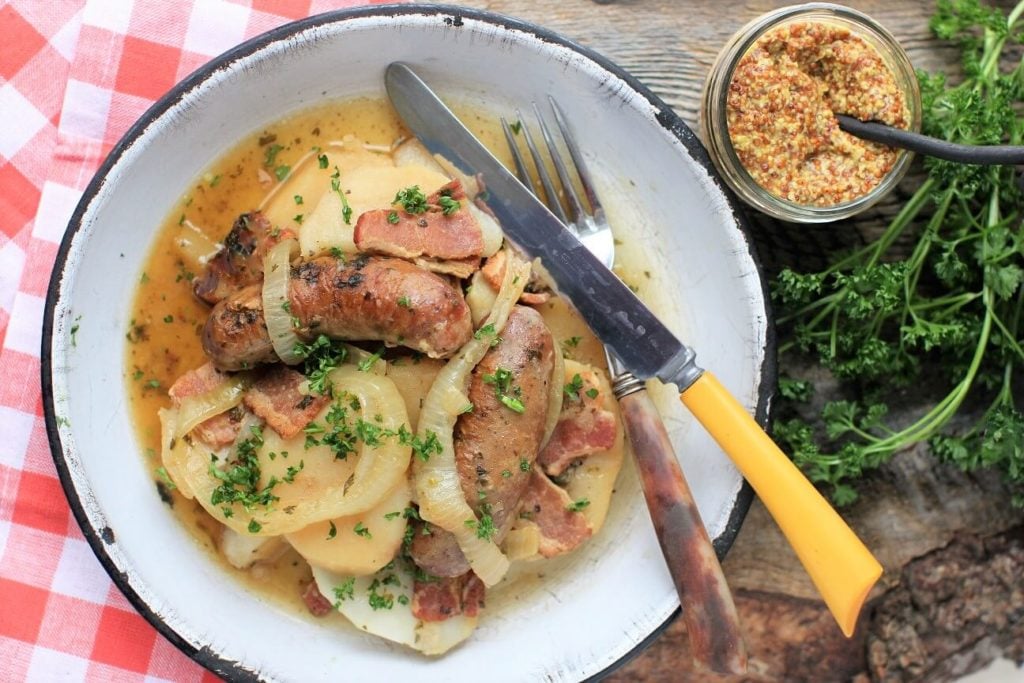Celebrate St. Patrick's Day with this traditional taste of Ireland. Dublin Coddle is a homey dish made of just a few simple ingredients that, when braised long and slow, meld together to become a delicious, comforting stew. Bacon, sausages, potato, and onion - what more can I say? (Skip to recipe.)
St. Patrick's Day is just the excuse you need to cook up a comforting pot of Dublin Coddle. After that, you'll want to make it whenever it's a little bit miserable outside and you want a big plate of something so deliciously simple and tasty you can forget about the weather. This slowly simmered pot of comfort food will warm the cockles of your heart, whether it's an Irish heart or not.
The origins of Dublin Coddle are (surprise, surprise) - Dublin. It's a dish that dates back at least to the eighteenth century, and was traditionally cooked to use up leftover sausages or rashers (bacon) from the week, before going meatless on Fridays. Leeks and oatmeal were originally used, but nowadays, potatoes and onion are most popular. The name most likely comes from the older word caudle which means 'to boil gently or stew'.
Dublin Coddle is a beautiful stew, brilliant in its simplicity; 5 ingredients that gently simmer together to become a fantastic, rich, flavourful dish. Meat and potatoes in a beautiful marriage (because, of course . . . that dashing groomsman . . . bacon!) The beauty of this stew is that it doesn't suffer from being kept warm for hours. Historically, busy cooks could braise up a cauldron of Dublin Coddle in the morning, then leave it to warm gently in the oven if they needed to be out of the house for the afternoon, and it was meltingly delicious and ready for the evening meal. It is said to have been the favourite meal of Irish authors Seán O'Casey and Jonathan Swift (Gulliver's Travels).
Digging around on the internet brought up a bit of information on this simple stew. It seems to be more of a city dish, possibly because its counterpart, Irish Stew, was made with mutton which was more available in the countryside, while in the city of Dublin, bangers and other sausages were more available and affordable. So, even though it's a working man's dish, homey and common, it's a bit more 'posh' than Irish Stew.
Five simple ingredients make up a Dublin Coddle: bacon or ham, sausages, potatoes, onions, and parsley.
You'll find all kinds of variations online, with added vegetables, herbs, and prepared broths. But if you want to stick to the original, just use these simple ingredients, with water as your liquid. Traditionally, the bacon and sausages are parboiled in water, and the resulting broth is used as the liquid for the stew, which seems redundant. I took the liberty of saving a step and just adding the water directly to the stew. I also browned the bacon first, because the idea of boiled bacon just didn't turn me on at all. The extra step of browning the bacon and sausage makes for a more beautiful-looking and deeply flavoured stew. I did make up one test batch of the stew the traditional way, not browning the sausages (I used ham instead of bacon). It was paler in colour and flavour, but was still very tasty. So if you're in a rush, you can save a step and still have a decent dinner.
Serve your Dublin Coddle with a hunk of rustic bread, like my gluten free Irish Soda Bread to sop up the juices and a pint of Guiness or a crisp hard apple cider ( a delicious gluten-free option) to wash it down. For a peek at my trip to Ireland a few years ago, where I managed to be in Dublin for St. Patrick's Day (so exciting), click on this link, and for another great St. Paddy's day recipe and story, check out this Green Soup.
If you can't make it to Ireland to experience the revelry and blarney of a true St. Patrick's Day celebration, grab yourself a knife and fork and tuck into a plate of Dublin Cobble instead. Sip a pint of your favourite brew and pretend you're in an Irish pub, trading stories with the locals while a fiddler plays a jig in the background.
Sláinte!
* * * * *
I've joined a group of bloggers, led by the intrepid Evelyne of CulturEatz, who will be showcasing a recipe from a different country around the world each month (#eattheworld). This month's country is, fittingly, Ireland. I am so excited about this project and can't wait to 'Eat the World' and discover all kinds of new international recipes! I had so much fun thinking of which recipe to post to showcase Ireland. Check below, after the recipe, to see what other Irish delights have been cooked up by my fellow bloggers on this exciting project. And check back on the 10th of every month to see what country we'll be eating in next.
* * * * *
Kitchen Frau Notes: The traditional way to make Dublin Coddle is to combine everything in the pot without browning the bacon or sausages. This saves time and an extra step. However, it doesn't look quite as visually appealing and doesn't have the full depth of flavour that comes from browning the meat. Bacon doesn't look very appetizing when boiled, so I prefer using ham instead of bacon when doing it this way. If you're short on time or don't want the grease spatter that comes from browning bacon and sausages, just layer everything in the Dutch oven, bring to a boil, cover, and simmer on the stovetop or in the oven for the recommended time. You'll be eating your Dublin Coddle like they did in olden times.
Dublin Coddle
- 8 slices (about 350gm/12oz) of lean, thick-cut bacon
- 2 lbs (900gms) potatoes (5 - 6 medium)
- 6-8 good quality lean pork sausages (about 600-800gms/1¼-1¾lbs), preferably bangers, but you can use any type - like bratwurst or other pork sausages (gluten-free if necessary)
- 3 large onions
- ¼ cup/4 tablespoons chopped parsley, plus some for garnish
- salt and pepper to taste (about ½ teaspoon of each)
- 3 cups (750ml) water or enough to come up about 1 inch (2.5cm) high in the pot
- grainy mustard and rustic bread to serve (my gluten-free Irish Soda Bread recipe here)
Cut the bacon into 1½ inch (3cm) pieces and partially cook them over medium heat in a large Dutch oven, until they start to turn golden, but are not crispy. Scoop them out and set them aside. Keep the bacon fat in the pan. Brown the sausages in the fat. The sausages don't need to be fully cooked as they will finish cooking during the simmering time. Do not drain the fat.
*If using smoked sausages, you can brown the bacon, but just cut the sausages into manageable lengths and add them without browning.
Peel the potatoes and the onions, and slice them thickly (pencil-thick, or cut the potatoes into chunks). Put half of the onions into the Dutch oven on top of the bacon fat. Layer on the potato slices. Add salt and pepper to taste. Sprinkle with half the parsley. Add the bacon. Lay the sausages (browned or not) on top. Add the rest of the onions and sprinkle with the rest of the parsley.
Pour on the water. Bring to a boil, then reduce the heat to a simmer. Cover the pot with a piece of tin foil that is bigger than the top of the pot. Put on the lid of the pot and press it down to make a tight seal over the tin foil, with the edges of the tin foil sticking out all the way around the pot. You can finish braising the stew in two ways:
1. Simmer the Dublin Coddle on the stovetop for 1 - 1½ hours. The stew is done after one hour of simmering, but can easily handle up to 2 hours. I like it after about 1½ hours.If there is too much liquid, remove the lid after 1 hour and simmer until the liquid is reduced somewhat.
OR
2. Bake in a 300°F/150°C oven for 3 hours, checking halfway and adding more water if the liquid level has dropped lower than 1 inch deep. If you need to keep the stew in the oven for longer, it can easily handle braising for up to 4 or 5 hours, as long as the liquid level is sufficient.
Taste, and add more salt and pepper if it needs it. Serve with grainy mustard on the side and a nice crusty bread to mop up the broth.
Serves 4 to 6, depending on the size of the appetites.
Guten Appetit!
Check out all the wonderful Irish dishes prepared by fellow Eat the World members and share with #eattheworld. Click here to find out how to join:
Evelyne: Irish Yellowman Candy
Amy: Cheesy Potato Soup with Irish Ale
Nicoletta and Loreto: Irish Chocolate Stout Cake
Wendy: Instant Pot Irish Stew with White Cheddar Crust
Camilla: Shamrock Salad-Topped Irish Boxty
Tara: Irish Baked Eggs with Spinach
Karen: Irish Potato Cakes
Sarah: Irish Parsnip Soup
Bernice: Potato Cabbage and Rutabaga Colcannon
Sign up here to receive new Kitchen Frau recipes directly to your email inbox, and get a handy and useful kitchen tip with each recipe.
If you like my recipes, follow me on Instagram, Pinterest, Twitter, and Facebook. You’d make my day!
Don’t forget to PIN IT to save the recipe:
You might also like:
Gluten Free Irish Soda Bread and Dublin for St. Patrick's Day
Green Soup (It'll Lure the Leprechauns)








Wendy
I agree with your assessment of browning the meat first. After all we first eat with our eyes and my eyes say your dish is delicious.
Margaret
Aw, I thank your eyes very much!! Simple food is sometimes just as appetizing as something fancy, isn't it?
Karen @Karen's Kitchen stories
This sounds soooo delicious! I love anything that tastes better after simmering for hours.
Margaret
I agree with you there - and the smells that waft through the house are so tantalizing (it's always about the bacon!!)
Nicoletta @sugarlovespices
Loreto would happily dig in that pot of Irish coddle! Looks so comforting and hearty, to warm you from the inside out!
Margaret
It IS a meat lovers kind of stew - a meat and potatoes kind of meal that really works in this tail end of winter we're having here. The men in my family go crazy for it, too.
Tara
Dublin Coddle is one of my favorites! I absolutely love your plating.
Margaret
Aw, thanks so much, Tara. It's a favourite of ours, too. (I mean - BACON!) It's a real comfort food!
Bernice Hill
I agree. I think pre browning the sausages and frying the bacon makes a huge difference in appearance. It's not easy to photograph stews but your photos are fab.
I would make this in a heartbeat!
Margaret
Thanks so much for your kind words, Bernice! I always curse the pre-browning of any dish when I've got grease spatters to clean up, but then when it's time to eat the dish, I'm always so happy I did. This is the kind of food that reminds me of home, plus I love the convenience of it – put it in the pot and leave it be!!!
Evelyne CulturEatz
Super hearty and delicious. Nothing beats a nice slow braise. I would be curious to try an oatmeal version too.
Margaret
Yes, I was really curious about the oatmeal version, too. I'm guessing it would almost be like a thick, savoury porridge, with BACON!Stick-to-your-ribs! Maybe I'll try one yet.
Amy's Cooking Adventures
This sounds over the top amazing! My family always loves a meat & potatoes dish!
Margaret
Thanks so much 🙂 There's something so comforting about meat and potatoes, isn't there (and then when you add bacon . . .)
Connie
This looks so good Margaret. I'm going to make it. What gf sausages did you use and where did you get them? We had this twice when we were in Ireland but I couldn't have the bread they served with it so I'm going to try your soda bread. Such nice comfort food!
Margaret
Thanks so much, Connie! I buy gluten free pork sausages at our local butcher (Sandyview Farms). They're really tasty and are gluten free and sugar free. However, I have bought some at Save-On Foods before, I think they were called Opa's Bratwurst, but can't totally remember. It's sometimes tricky to find gluten free raw pork sausages - you really have to look around. If you can't find any, even breakfast sausages should work (Costco has some good ones) or smoked sausages would work if you can't find any others. They'd add more of a smoky flavour (but you wouldn't have to brown them first) but aren't as soft and tender when braised as the raw ones are.
And you're right - this kind of a simmered meat and potato dish is pure comfort food (and great memories of Ireland!)